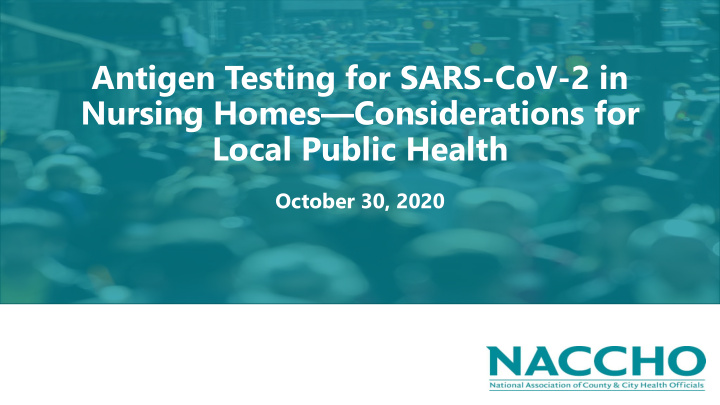



Antigen Testing for SARS-CoV-2 in Nursing Homes — Considerations for Local Public Health October 30, 2020
Speaker Introduction Dr. Sujan Reddy Medical Officer for the Division of Healthcare Quality Promotion Centers for Disease Control and Prevention (CDC)
Logistics • This webinar is being recorded and the recording will be shared along with slides • Submit questions through the Q&A Box at any time. We will discuss questions at the end of the presentation. • If you need technical assistance, please use the Q&A box
Antigen Testing for SARS-CoV-2 in Nursing Homes: Considerations for Local Public Health Sujan Reddy, MD MSc Division of Healthcare Quality Promotion 10/30/20 cdc.gov/coronavirus
Outline ▪ Describe testing recommendations in nursing homes ▪ Discuss current CDC guidance on antigen testing in nursing homes ▪ Provide an opportunity to ask questions and engage in open discussion.
Purpose of testing ▪ Identify cases early – Prevent introduction – Prevent transmission ▪ (Determine resolution of infection) ▪ Testing should be implemented in addition to recommended IPC measures ▪ Testing should aim for rapid turnaround times (e.g., less than 24 hours) in order to facilitate effective interventions https://www.cdc.gov/coronavirus/2019-ncov/hcp/nursing-homes-testing.html
Current Recommendations For Testing In Nursing Homes ▪ Symptomatic testing : – Test all symptomatic residents and staff ▪ Outbreak testing: – A new SARS-CoV-2 infection in any healthcare personnel (HCP) or any nursing home- onset SARS-CoV-2 infection in a resident should prompt immediate investigation – Immediately test all residents and staff, then serially test every 3-7 days until no new cases for 14 days ▪ Non-outbreak testing: – Baseline testing : Test all residents and staff once as part of reopening – Serial staff screening : test asymptomatic staff at frequency determined by county positivity rate (monthly, weekly, twice weekly) https://www.cdc.gov/coronavirus/2019-ncov/hcp/nursing-homes-testing.html
Initiate outbreak testing immediately ▪ Transmission can be rapid – Estimated doubling time of 3.4 days – For each day that the outbreak response is delayed, 1.3 additional cases are identified Arons M et al, NEJM 2020 Hatfield K et al. MMWR 2020
Outbreak testing should be done serially ▪ Test all residents and staff every 3-7 days until no new cases for 14 days ▪ Most cases are identified in the first 2 weeks from index case ▪ If resources allow, consider testing more frequently (e.g., every 3 days) for the first two weeks of the outbreak, then test less frequently (e.g., every 7 days) thereafter until no new cases are identified for 14 days – Example: testing on day 0 (day the first case is identified), days 3, 6, 9, and 12, and then on days 19, 26, etc. https://www.cdc.gov/coronavirus/2019-ncov/hcp/faq.html#Testing-in-Nursing-Homes
Non-outbreak screening of asymptomatic nursing home HCP ▪ Testing intervals based on risk of transmission of SARS-CoV-2 in community, defined by county positivity rate in the past week – Weekly reports available on CMS COVID-19 data website ▪ Routinely testing asymptomatic residents in non-outbreak settings is not recommended https://www.cms.gov/files/document/qso-20-38-nh.pdf https://www.cdc.gov/coronavirus/2019-ncov/lab/resources/calculating-percent-positivity.html https://www.cdc.gov/coronavirus/2019-ncov/hcp/faq.html#Testing-in-Nursing-Homes
Prioritizing testing when capacity is limited ▪ Prioritize testing 1) Residents and healthcare personnel (HCP) with signs or symptoms of COVID-19 and 2) Asymptomatic residents and HCP in response to an outbreak in the facility. ▪ When testing capacity is limited or test turnaround times are >2 days, testing HCP who are asymptomatic in facilities without an outbreak should be considered lower priority. https://www.cdc.gov/coronavirus/2019-ncov/hcp/faq.html#Testing-in-Nursing-Homes
Implementing SARS-CoV-2 viral testing ▪ Identify a process for ordering, documenting and communicating results, and funding tests obtained for residents and HCP ▪ Maintain availability of the specimen collection kits, test kits and reagents (for onsite testing), and personal protective equipment used for specimen collection and handling – HCP conducting specimen collection should receive training on safe specimen collection and handling https://www.cdc.gov/coronavirus/2019-ncov/hcp/nursing-homes-facility-wide-testing.html
SARS-CoV-2 viral testing: Molecular vs. antigen https://www.cdc.gov/coronavirus/2019-ncov/lab/resources/antigen-tests-guidelines.html
Considerations for interpreting antigen testing results https://www.cdc.gov/coronavirus/2019-ncov/hcp/nursing-homes-antigen-testing.html
Guidance for SARS-CoV-2 Point-of-Care Testing ▪ Regulatory requirements ▪ CLIA-certificate of waiver ▪ Specimen collection and handling – Risk assessment – Quality control and instrument calibration – Personal protective equipment considerations ▪ Reporting of results https://www.cdc.gov/coronavirus/2019-ncov/lab/point-of-care-testing.html
CDC Testing Guidance https://www.cdc.gov/coronavirus/2019-ncov/hcp/nursing-homes- testing.html https://www.cdc.gov/coronavirus/2019-ncov/hcp/testing-healthcare- personnel.html
COVID-19 Resources for Nursing Homes ▪ CDC COVID-19 Resource Page – Infection Control Guidance – Testing guidance – Assessment tools – Training materials https://www.cdc.gov/coronavirus/2019-ncov/hcp/nursing-home-long-term-care.html
For more information, contact CDC 1-800-CDC-INFO (232-4636) TTY: 1-888-232-6348 www.cdc.gov The findings and conclusions in this report are those of the authors and do not necessarily represent the official position of the Centers for Disease Control and Prevention.
Discussion Please enter your questions or comments in to the Q&A box
Thank you for joining today’s webinar! Contact us with questions Email: infectiousdiseases@naccho.org
Recommend
More recommend